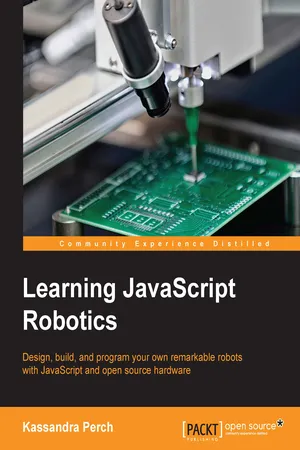
- 160 pages
- English
- ePUB (mobile friendly)
- Available on iOS & Android
Learning JavaScript Robotics
About This Book
Design, build, and program your own remarkable robots with JavaScript and open source hardware
About This Book
- Learn how to leverage Johnny-Five's Read, Eval, Print Loop, and Event API to write robot code with JavaScript
- Unlock a world of exciting possibilities by hooking your JavaScript-programmed robots up to the internet and using external data and APIs
- Move your project code from the Arduino Uno to a multitude of other robotics platforms
Who This Book Is For
If you've worked with Arduino before or are new to electronics and would like to try writing sketches in JavaScript, then this book is for you! Basic knowledge of JavaScript and Node.js will help you get the most out of this book.
What You Will Learn
- Familiarise yourself with Johnny-Five Read, Eval, and Print Loop (REPL) to modify and debug robotics code in real time
- Build robots with basic output devices to create projects that light up, make noise, and more
- Create projects with complex output devices, and employ the Johnny-Five API to simplify the use of components that require complex interfaces, such as I2C
- Make use of sensors and input devices to allow your robotics projects to survey the world around them and accept input from users
- Use the Sensor and Motor objects to make it much easier to move your robotics projects
- Learn about the Animation API that will allow you to program complex movements using timing and key frames
- Bring in other devices to your Johnny-Five projects, such as USB devices and remotes
- Connect your Johnny-Five projects to external APIs and create your own Internet of Things!
In Detail
There has been a rapid rise in the use of JavaScript in recent times in a variety of applications, and JavaScript robotics has seen a rise in popularity too. Johnny-Five is a framework that gives NodeBots a consistent API and platform across several hardware systems.
This book walks you through basic robotics projects including the physical hardware builds and the JavaScript code for them. You'll delve into the concepts of Johnny-Five and JS robotics.
You'll learn about various components such as Digital GPIO pins, PWM output pins, Sensors, servos, and motors to be used with Johnny-Five along with some advanced components such as I2C, and SPI. You will learn to connect your Johnny-Five robots to internet services and other NodeBots to form networks. By the end of this book, you will have explored the benefits of the Johnny-Five framework and the many devices it unlocks.
Style and approach
This step-by-step guide to the Johnny-Five ecosystem is explained in a conversational style, packed with examples and tips. Each chapter also explores the Johnny-Five documentation to enable you to start exploring the API on your own.
Frequently asked questions
Information
Learning JavaScript Robotics
Table of Contents
Table of contents
- Learning JavaScript Robotics